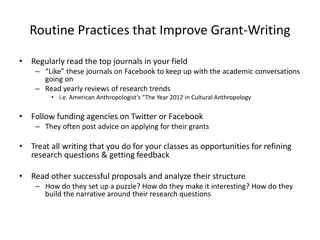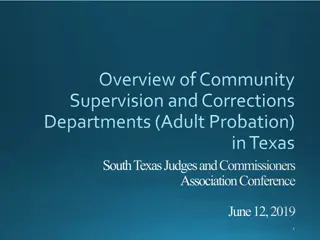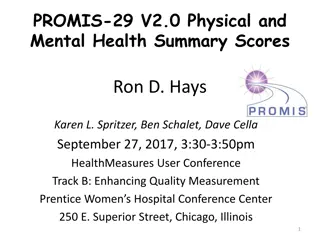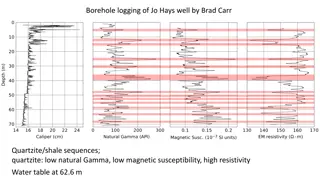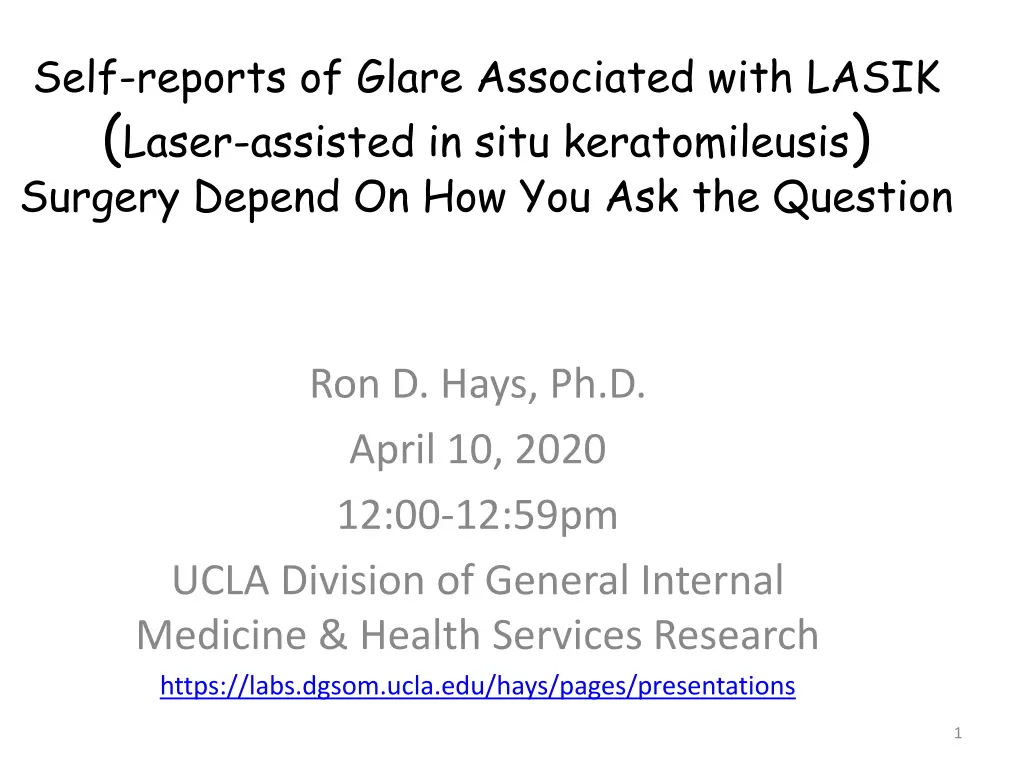
Understanding Glare Following LASIK Surgery
Explore the impact of glare associated with LASIK surgery, how it is reported, and the potential discomfort and disability it can cause. Learn about patient-reported outcomes and assessments like the Brightness Acuity Test. Discover insights on glare before and after LASIK surgery to better understand this common phenomenon.
Uploaded on | 3 Views
Download Presentation

Please find below an Image/Link to download the presentation.
The content on the website is provided AS IS for your information and personal use only. It may not be sold, licensed, or shared on other websites without obtaining consent from the author. If you encounter any issues during the download, it is possible that the publisher has removed the file from their server.
You are allowed to download the files provided on this website for personal or commercial use, subject to the condition that they are used lawfully. All files are the property of their respective owners.
The content on the website is provided AS IS for your information and personal use only. It may not be sold, licensed, or shared on other websites without obtaining consent from the author.
E N D
Presentation Transcript
Self-reports of Glare Associated with LASIK (Laser-assisted in situ keratomileusis) Surgery Depend On How You Ask the Question Ron D. Hays, Ph.D. April 10, 2020 12:00-12:59pm UCLA Division of General Internal Medicine & Health Services Research https://labs.dgsom.ucla.edu/hays/pages/presentations 1
Disclaimer This work-in-progress presents an unfunded secondary analysis of data collected in 2011-2014. The opinions expressed here do not necessarily represent those of the United States Food and Drug Administration or the National Eye Institute. I am responsible for all errors or omissions. 2
Laser Eye Surgery Refractive surgery used to correct near-sightedness, far-sightedness and astigmatism (irregularly shaped cornea). Reshapes corneas to improve visual acuity. Possible complications/side effects include: Glare (Halos), dry eyes, sensitivity to light, night vision 3
Glare reported by 38% before, 38% 1-month after, and 43% 3-months after LASIK 4
Glare Glare occurs when the object in view is blocked partially or fully by a dazzling light. Glare can occur from bright lights such as streetlamps or headlights. Snowballs, halos, starbursts and streaks are all examples of glare and are shown below. 5
Discomfort and Disability Glare Discomfort glare occurs when the intensity of the light source is annoying to one s eyes. Disability glare means there is visual impairment caused by the scattering of light entering one s eyes. 6
BAT (Brightness Acuity Test) Glare disability assessed by seeing if vision worsens when mimicking partly cloudy day, bright overhead commercial lighting, and direct overhead sunlight. 7
Patient-Reported Outcomes With LASIK (PROWL) Funded by the Department of Health and Human Services and the Department of Defense Corresponding author: Malvina Eydelman, MD, Center for Devices and Radiological Health, US Food and Drug Administration Hays, R. D., Tarver, M. E., Spritzer, K. L., Reise, S., Hilmantel, G., Hofmeister, E. M., Hanmel, K., May, J., Ferris, F., & Eydelman, M. (2017). Psychometric properties of a questionnaire assessing patient-reported outcomes with LASIK (PROWL). JAMA Ophthalmology, 135 (1), 3-12. Eydelman, M., Hilmantel, G., Tarver, M. E., Hofmeister, E. M., May, J., Hammel, K., Hays, R. D., & Ferris, F. (2017). Symptoms and satisfaction in the LASIK Quality of Life Collaboration Project. JAMA Ophthalmology., 135 (1), 13-22. . 8
PROWL Observational study of 511 patients (analytic sample) who had LASIK surgery for myopia, hyperopia, or astigmatism and completed questionnaire online before and after (1-month and 3-months) surgery. * PROWL-1: single-center study of 240 active-duty US Navy personnel. 55% white, 9% black, 9% Asian, 20% Hispanic 20% women; median age = 27 (range: 21-52) * PROWL-2: 5-center study of 271 civilians. 76% white, 2% black, 12% Asian, 4% Hispanic 54% women; median age = 30 (range: 21-57) PROWL study participants completed a questionnaire assessing eye-related symptoms (glare, starbursts, halos, and double images) using a secure website accessed by computer. Analytic sample completed baseline and at least one follow-up questionnaire. 9
PROWL Prospective observational study of 511 patients having LASIK surgery for myopia, hyperopia, or astigmatism. A recent clinical trial by the F.D.A. suggests that the complications experienced by Mr. Ramirez are not uncommon. https://www.nytimes.com/2018/06/11/well/lasik-complications- vision.html 10
National Eye Institute (NEI)-RQL Glare Question Have you experienced glare in the last 7 days? - Yes - No Item 33 on 161-question baseline (preoperative) questionnaire (20%). Item 27 on 129-question post-surgery questionnaires (21%). Hays, R. D., Mangione, C. M., Ellwein, L., Lindblad, A. S., Spritzer, K. L., McDonnell, P. J., and NEI-RQL Research Group. (2003). Psychometric properties of the National Eye Institute Refractive Error Quality of Life Instrument. Ophthalmology, 110 (12), 2292-2301. 11
Definition and Picture of Glare INSTRUCTIONS: The next few questions are about glare. By glare, we mean difficulty seeing well when there are bright lights like headlights or sunlight, such as shown in the images below. These images may not represent exactly what you see and your symptoms may be more or less severe than what is shown. No Glare Severe Glare 12
Picture Glare Question In the last 7 days, have you noticed any glare? - Yes, but ONLY when NOT wearing glasses or contact lenses - Yes, but ONLY when wearing glasses or contact lenses - Yes, when wearing AND when not wearing glasses or contact lenses - No, not at all Item 50 on 161-item baseline questionnaire (31%). Item 47 on 129-item post-surgery questionnaire (36%). 13
28% (150/544) glare on NEI-RQL item Baseline n = 544 (Note: This includes all available data so is larger than analytic sample.) Have you experienced glare in the last 7 days? (NEI-RQL) No Yes No 297 35 In the last 7 days, have you noticed any glare? (Picture) Yes 97 115 Column totals 394 150 (28%) 14
28% glare on NEI-RQL item 39% glare on Picture item Baseline N = 544 Have you experienced glare in the last 7 days? (NEI-RQL) No Yes Row Totals No 297 35 332 In the last 7 days, have you noticed any glare? (Picture) Yes 97 115 212 (39%) Column totals 394 150 (28%) 544 76% agreement; kappa =0.46 (r = 0.48; alpha = 0.64) 15
Guidelines for Interpreting Kappa Conclusion Kappa Conclusion Kappa Poor Slight < 0.0 .00 - .20 Poor < .40 Fair .21 - .40 Fair .40 - .59 Moderate .41 - .60 Good .60 - .74 > .74 Substantial .61 - .80 .81 - 1.00 Excellent Almost perfect Fleiss (1981) Landis and Koch (1977)
I am more sensitive than other people. MMPI 317 True False 169 15 184 True MMPI 362 False 21 95 116 190 110 88% agreement; kappa = 0.74 (r = 0.75) Hays, R. D., & Revetto, J. P. (1992). Old and new MMPI-derived scales and the Short-MAST as screening tools for alcohol disorder. Alcohol and Alcoholism, 27, 685-695.
Guidelines for Interpreting Kappa Conclusion Kappa Conclusion Kappa Poor Slight < 0.0 .00 - .20 Poor < .40 Fair .21 - .40 Fair .40 - .59 Moderate .41 - .60 Good .60 - .74 > .74 Substantial .61 - .80 .81 - 1.00 Excellent Almost perfect Fleiss (1981) Landis and Koch (1977)
Kappa of 0.46 is comparable to reliability of single items in multi-item scales Item Reliability Scale Reliability Number of scale items 0.64 0.90 5 0.47 0.90 10 0.38 0.90 15 0.44 0.80 5 0.28 0.80 10 0.21 0.80 15 0.32 0.70 5 0.19 0.70 10 0.13 0.70 15 19
Two-Item Glare Scale NEI Picture Sum Score No No 0 Yes No 1 No Yes 1 Yes Yes 2 20
Mean Scores By Combinations of Two Glare Items (Baseline) A B C D No on Both (n = 297) Yes on NEI-RQL only (n = 35) Yes on Picture only (n = 97) Yes on Both (n = 115) 90a 69b 63a,b 56c Halos 85a 57b 60b 53b Starbursts 92a 84b 81b 79b Double images 11b 22a,b 20b 26a Ocular Surface Disease Index (OSDI) - Ocular irritation consistent with dry eye disease. 45a 41a,b 37a,b 33b Satisfaction with Vision All scales on a 0-100 possible range. Higher score is better except for the OSDI. 21
Significant Product-Moment (Spearman) Correlations and Standardized OLS Regression Coefficients with Two-Item Glare Scale (Baseline) Correlations Standardized Betas Halos (8 items) -0.52 (-0.54) -0.31 Starbursts (8 items) -0.48 (-0.49) -0.19 Ocular Surface Disease Index (OSDI, 5 items) 0.41 (0.42) 0.19 Double images (8 items) -0.28 (-0.28) NS Optimism (6 items) -0.19 (-0.17) -0.11 Satisfaction with vision (1 item) -0.18 (-0.17) NS Depressive symptoms (PHQ-4) 0.17 (0.13) NS All scales except OSDI and PHQ-4 scored so that higher is better. Adjusted R2 = 35% 22
Summary of Results So Far NEI-RQL and Picture glare items correlate as highly with one another as typical items in multi- item scales assessing the same concept. Reporting glare on neither item indicates less glare and reporting glare on both items indicates more glare. Sum of 2 glare items is associated most strongly with halos and starbursts. 23
Change in % Yes on NEI-RQL and Picture Glare Items From Baseline to Post-Surgery NEI-RQL Picture Baseline 3-months Baseline 3-months 27% 27% 38% 25% Baseline -> 3-months significant 24
Change in % Yes on NEI-RQL and Picture Glare Items From Baseline to Post-Surgery NEI-RQL Picture Baseline 1-month 3-months Baseline 1-month 3-months 27% 42% 27% 38% 34% 25% Baseline -> 1-month significant Baseline -> 3-months significant 25
Cross-tab of Two Glare Items (n = 492) Baseline (Column %) 1-month post-baseline (Column %) No to Both 270 (55%) 243 (49%) 6% points Yes to Both 100 (20%) 124 (25%) 5% points Only NEI Yes (Picture No) 32 (7%) 83 (17%) 10% points Only Picture Yes (NEI No) 90 (18%) 42 (9%) 9% points 26
Discussion Results argue for 2-item glare scale: - Baseline (~45%), 1-month (51%), 3-months (33%) But we are still left wondering why at the 1-month follow-up when glare is only endorsed on one item - NEI-RQL glare went up from 7% at baseline to 17% - 27% to 42% overall (15 percentage points up) - Picture glare went down from 18% to 9% ? - 39% to 34% overall (~5 percentage points down) Targeted cognitive interviews may help.
Questions? https://www.fda.gov/media/101445/download https://www.fda.gov/medical-devices/lasik/lasik-quality-life-collaboration-project https://www.fda.gov/medical-devices/lasik/lasik-quality-life-collaboration- project#publications 28
Appendix Glare (8 items) In the last 7 days, have you noticed any glare? [Yes, without glasses or contact lenses; Yes, even wearing glasses or contact lenses; No, not at all] In the last 7 days, how often have you noticed glare when you are wearing your best vision correction (glasses or contact lenses)? [Never; Rarely; Sometimes; Often; Always; I do not use any vision correction] In the last 7 days, how often have you noticed glare when you are NOT wearing any vision correction? [Never; Rarely; Sometimes; Often; Always; I always use vision correction] In the last 7 days, how bothersome has the glare been when you are wearing your best vision correction (glasses or contact lenses)? [Extremely bothersome; Very bothersome; Somewhat bothersome; A little bothersome; Not at all bothersome; I do not use any vision correction] In the last 7 days, how bothersome has the glare been when you are NOT wearing any vision correction? [Extremely bothersome; Very bothersome; Somewhat bothersome; A little bothersome; Not at all bothersome; I always use vision correction] In the last 7 days, how much difficulty have you had doing your usual activities because you noticed glare when you are wearing your best vision correction (glasses or contact lenses)? [No difficulty at all; Very little difficulty; Moderate difficulty; A lot of difficulty; So much difficulty that I can no longer do some of my usual activities; I do not use any vision correction] In the last 7 days, how much difficulty have you had doing your usual activities because you notice glare when you are NOT wearing any vision correction? [No difficulty at all; Very little difficulty; Moderate difficulty; A lot of difficulty; So much difficulty that I can no longer do some of my usual activities; I always use vision correction] When you use your best vision correction (glasses or contact lenses) does the glare you notice: [Go away completely; Go away mostly; Go away a little; Not change; Get a little worse; Get a lot worse; I do not use any vision correction (glasses or contact lenses)] 29
PROWL-2 Sites 20/20 Institute (Indiana) Durrie Vision (Kansas) Johns Hopkins University (Maryland) Stanford University (California) Vance Thompson (South Dakota) 30



